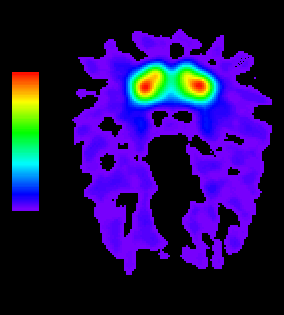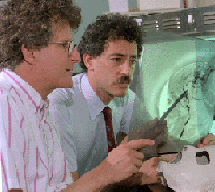
Cooperative Research

This PET scan image showing chemical uptake in the brain
of a monkey is
being used to test the effectiveness of a treatment for
Parkinson's disease.
The scan was one of the preliminary experiments done under
an LBL
partnership with Somatix Therapy Corporation.
AS A NATIONAL LABORATORY that receives the bulk of its
funding from the U.S. Department of Energy but is managed by the University of
California, LBL has traditionally maintained strong ties to both the federal
and state government. As a national laboratory located near the heart of this
country's computer-based high-tech and biotechnology industries, LBL has also
formed strong ties to the private sector of the economy in those research areas
that benefit the lab's scientific mission. This past year, to better coordinate
these two vital connections, LBL consolidated its government and community
relations office and its technology transfer department into the Office of
Industry and Government Partnerships (IGP). The thrust of IGP's mission will be
to speed the process by which the knowledge gained from LBL's scientific
research is converted into technological goods and services that will benefit
the taxpayers who paid for the research.
Five years ago, Congress passed legislation that permitted federally-funded
laboratories for the first time to enter into cooperative research ventures
with private industry. This legislation led to the establishment of Cooperative
Research and Development Agreements (CRADAs) as the primary vehicle for
transferring technology from the national labs to commercial applications. Last
year, LBL signed 27 CRADAs, including ten Energy Research Laboratory Technology
Transfer (ER-LTT) awards, which are funded by DOE's Office of Energy Research
and are considered the most prestigious. Several of these ER-LTT awards have
far-reaching potential for the American public.
In a $2.5 million partnership with the Somatix Therapy Corporation, LBL will
put its expertise in medical imaging to work against Parkinson's disease.
Somatix will use its genetic engineering techniques to create special skin
cells that produce a chemical found in the brain called "dopamine,"
deficiencies of which are thought to cause Parkinson's disease. LBL will then
use its Positron Emission Tomography (PET) and Single Photon Emission Computed
Tomography (SPECT) techniques, which are carried out on a machine that provides
the highest resolution in the world, to test the therapeutic effectiveness of
these special skin cells (called fibroblasts).
In another ERL-TT award, LBL has reached a $1.5 million agreement with the
pharmaceutical firm of Rhone Poulenc-Rorer, Inc. LBL researchers will use the
transgenic mice (mice that carry human genes in their chromosomes) they have
developed to identify and clone the defective genes thought to be a cause of
diabetes and obesity. Researchers at Rhone Poulenc-Rorer will then use this
genetic material to develop drugs to treat the diseases in humans.
The commercial market for "flat-panel displays"--computer screens that are as
thin as a credit card--is expected to grow to $20 billion by the year 2000. LBL
has signed a $1 million ERL-TT award with SI Diamond, Inc., to study the
physical properties of "amorphous diamond"--a noncrystalline or liquid-like
form of diamond. Amorphous diamond is the basis for the company's unique "cold
cathodes." Conventional computer monitors are lit by a cathode-ray electron gun
that scans its electron beam back and forth across a grid of phosphor
chemicals. SI Diamond has replaced the electron gun with an array of thousands
of tiny electron sources--made from amorphous diamonds--that are called "cold
cathodes" because they emit electrons at low temperatures. Cold cathodes are
three times more energy efficient than conventional cathode-ray guns, but
researchers need to know more about amorphous diamonds in order to create the
large, homogenous surfaces needed for displays. LBL will provide the imaging
expertise and equipment needed to obtain this information.
In a related effort, LBL researchers have also teamed up with researchers at
Hewlett-Packard Laboratories to develop a better blue light-emitting diode
(LED). Blue LED technology is considered to be the key to the emergence of the
next generation of flat-panel displays which would be brighter than the liquid
crystal displays in use today. Blue LEDs are also a prerequisite to blue diode
lasers, a long-sought technological innovation that would quadruple the amount
of information that can be recorded on a CD-ROM.
A number of high-technology products have already entered the
marketplace as a result of CRADAs between LBL and private industry. Three of the more
prominent
this past year: a blood test based on antisera developed at LBL that was
marketed to hospitals in the U.S. by Diagnostics Systems Laboratory, Inc.;
Superconducting Quantum Interference Devices (SQUIDs) which were produced by
Conductus, Inc., based on superconducting materials developed at LBL, for use
in non-invasive medical and geophysical instruments that measure faint changes
in magnetic fields; and a computer software system called Hydrophysical Logging
Technology, which was developed jointly by LBL and the Colog Company, that is
being used by geologists to characterize the movement of water underground.
LBL does not only transfer technology to the private sector for
commercialization. Other valuable technology is transferred to the public
sector as well--technology that can mean the difference between life and death.
One example started with small-scale test programs in 1979 in which LBL
researchers began the development of a radiosurgical technique that uses highly
energized beams of protons or heavy ions (charged atoms with more than one
proton in their nucleus). Because such beams deposit all of their energy at a
single, precisely measurable point (as opposed to x-rays which distribute their
radiation indiscriminately), they can be used in sensitive tissue and organs
with little risk of complications. Through years of careful testing, this
radiosurgical technique proved safe and highly effective in the treatment of
certain forms of eye cancer and the deadly blood clots deep inside the brain
known as arteriovenous malformations (AVMs) that would otherwise have been
inoperable.

LBL physicist Kenneth Frankel (left) and physician
Richard Levy examine a film showing brain abnormalities.
In the past year, LBL researchers completed a project to transfer its eye
cancer program to the University of California at Davis, and signed an
agreement with Loma Linda University to transfer its AVM treatment to that
institution's Medical Center. The UC Davis clinic expects to use the technique
to treat as many as 40 people this year for uveal melanoma. In the past, the
only alternative to save the lives of uveal melanoma victims was to remove the
eye.
The transfer of the AVM technology to Loma Linda is expected to take about two
years. It is estimated that some 300,000 individuals in this country suffer
from AVMs, which typically appear in otherwise healthy young people and can
cause lethal or permanently disabling brain hemorrhages and seizures. The LBL
treatment technique has achieved a cure rate of greater than 85 percent on
patients suffering from the most extreme cases of AVMs.

Return to the Table of
Contents of the 1994 Regents Report




